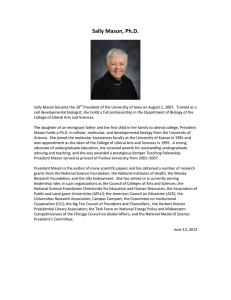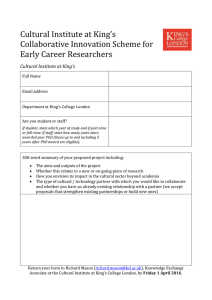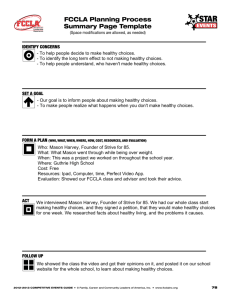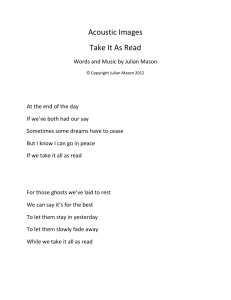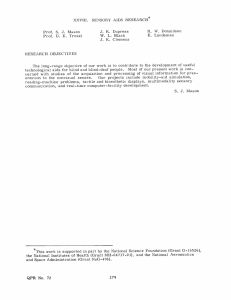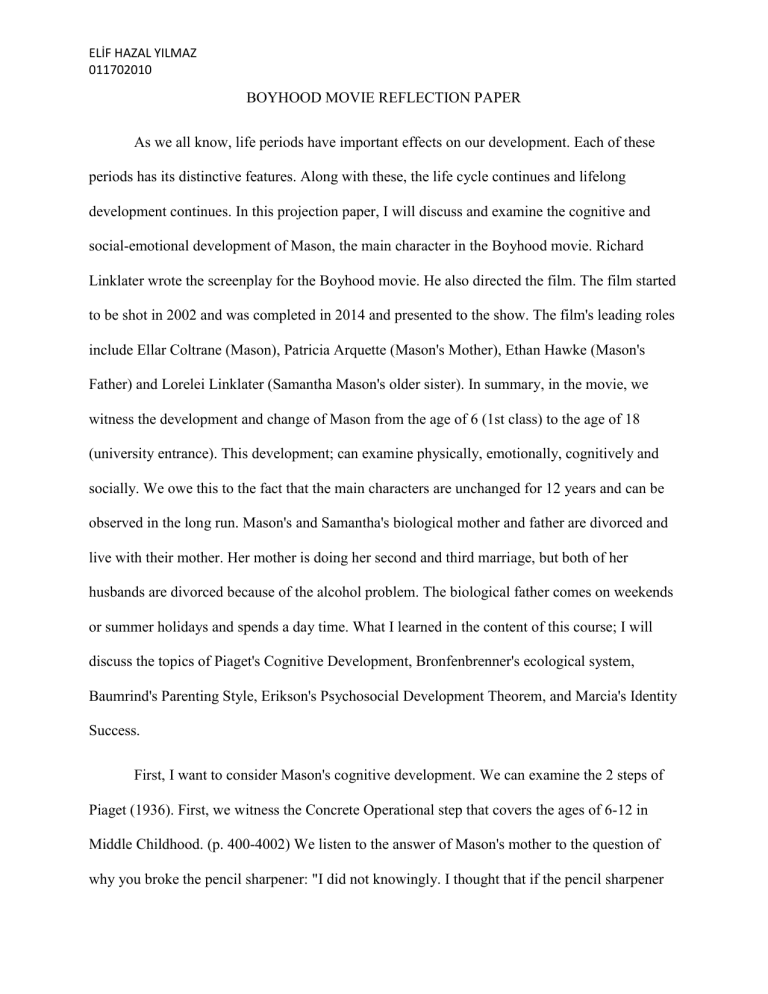
ELİF HAZAL YILMAZ 011702010 BOYHOOD MOVIE REFLECTION PAPER As we all know, life periods have important effects on our development. Each of these periods has its distinctive features. Along with these, the life cycle continues and lifelong development continues. In this projection paper, I will discuss and examine the cognitive and social-emotional development of Mason, the main character in the Boyhood movie. Richard Linklater wrote the screenplay for the Boyhood movie. He also directed the film. The film started to be shot in 2002 and was completed in 2014 and presented to the show. The film's leading roles include Ellar Coltrane (Mason), Patricia Arquette (Mason's Mother), Ethan Hawke (Mason's Father) and Lorelei Linklater (Samantha Mason's older sister). In summary, in the movie, we witness the development and change of Mason from the age of 6 (1st class) to the age of 18 (university entrance). This development; can examine physically, emotionally, cognitively and socially. We owe this to the fact that the main characters are unchanged for 12 years and can be observed in the long run. Mason's and Samantha's biological mother and father are divorced and live with their mother. Her mother is doing her second and third marriage, but both of her husbands are divorced because of the alcohol problem. The biological father comes on weekends or summer holidays and spends a day time. What I learned in the content of this course; I will discuss the topics of Piaget's Cognitive Development, Bronfenbrenner's ecological system, Baumrind's Parenting Style, Erikson's Psychosocial Development Theorem, and Marcia's Identity Success. First, I want to consider Mason's cognitive development. We can examine the 2 steps of Piaget (1936). First, we witness the Concrete Operational step that covers the ages of 6-12 in Middle Childhood. (p. 400-4002) We listen to the answer of Mason's mother to the question of why you broke the pencil sharpener: "I did not knowingly. I thought that if the pencil sharpener ELİF HAZAL YILMAZ 011702010 could open the pencil, it could open the stone. " In this sentence, we see that he did this by making use of his observations to generalize the function of the sharpener. In other words, using the general principle of the pencil sharpener, he predicted the outcome of an event - the stone can also be sharpened. This event is inductive reasoning, a feature of this period. We can also say that it uses the trial-error method. I mean, trying to shave the stone and shaving it more than once has resulted in an error, that is, a sharpener break. Another example was that at the very beginning of the movie, Mason found where the wasps came from, and that it turned into a wasp when he threw the water at a certain angle. I think there is some kind of logical use here, I think it shapes his mind. We can take it as appropriate use of logic, or as a limitation in this period. Because he has to inquire about where the bees come from, and since he did not have direct experience with this formation, his association with water may show that he has difficulty in questioning. In his physical development, we can see that he can ride from gross motor movements and can graffiti as a fine motor movement depending on the good eye-hand coordinate. In the Formal Operational Stage,(p.530-532) Mason was able to apply the information he learned and researched as a result of abstract thinking and questioning to his real life. For example, he plans to delete his Facebook account in case his secretion to dopamine in his brain is due to a technological tool. As a male Naïve Idealist, he believes that everything will change with the university, but he is also aware that this will not be the key to his life. So it's sort of doing hypothetical-deductivereasoning.(p.533) As we all know, environments such as families, neighbors, schools, and governments form the child's development environment. Urie Bronfenbrenner's Ecological System Theory also support that idea(p. 343) In the movie, we see the events and difficulties that Mason experienced as he grew up, for example; being abandoned by his father, graduating, birthdays, abuse, bullying, etc.…. Mason highly influenced from his Micro System; his parents divorced and he lives with his single mother also Olivia ends up both two marriage because of ELİF HAZAL YILMAZ 011702010 alcohol problems and abusive attitudes. Tend to befriend with older boys who influenced him. He moves frequently do not have a stable neighborhood. In Mesosystem, Mason's mom takes him from school and met with his teacher and talked about her son's position. The most influence in Mason's Exosystem was his mother's decision to move and go back to college to earn money and support them. Her mother's master's degree and job situation influence Mason's home-life. In the macrosystem, his culture said differently than what he wants in the university and occupational part. And lastly the choronosystem it can be his mother's three divorce situation. Diana Baumrind's (1971, 1980) theory, which associates the developmental results of Parenting Style with children's behaviors and Mason’s homework every evening and explains why he should submit the assignments and ask why. But later on, Oliva adopts the Permissive Parenting Pattern, for example, on the return of Mason's 15th birthday home, drunk and beautiful Olivia asks if he just smokes. Mason's biological father, on the other hand, displayed a Neglectful Parenting Pattern when he was absent, but when he returned, he also displayed a Permissive Parenting Pattern. However, both of their step-dads have Authoritarian Parenting Patterns. In terms of the psychosocial development of Erikson, we witness the 2 steps that Mason experienced in the film. Firstly, in the "Industry vs. Inferiority" that covers the ages of 6 -10/12, Mason's mother chose an authoritarian father for her children in her marriage. It was humiliating for Mason that Mason cut his hair without asking him. However, this situation can be regulated by the biological father's approach and interest. In the "Identity vs. Identity Confusion" step that appears during adolescence, a period in which Mason tries to find his own identity also changes in appearance. While using his hair long and in the form of emo, he then gives another shape, his voice tone changes, he acquires a lover and applies nail polish because he thinks he is cool with the influence of friends. He is emotionally afraid of people's judgments and in general, does not share his feelings with people. He thinks that the people he speaks to control him. He wants to do ELİF HAZAL YILMAZ 011702010 whatever he wants in a world where nobody controls him, and only then thinks he can look supposedly normal. He has concerns about his future but still knows that he wants to make art, to develop himself in photography. So, based on the Identity Achievement Theory of Marcia (1966, 2002), Mason doesn't just think that he can make a real transformation by going through the photograph, going to the university, and this is not the key to his future. He is still in the Moratorium stage, and according to Erikson, at the age of 20, this confusion must have ended. Identity seeking, Identity vs Identity Confusion is the biggest feature of the stage, but when we look at today, we are still looking for answers. We can say that Mason is at the stage of Emerging Adulthood, the last topic we learned. Mason is stuck in this situation and is still on his way to identity acquisition. This is not a sharp process, and it remains valid in today's world. (p. 575576) Mason is not a stereotypical "troubled teenager" despite encountering many tough events. Her parent's divorce, he is subjected to peer pressure and submits to it, but as he matures, he becomes more harmonious and more thoughtful. Mason's journey to young adulthood or emerging adulthood has elements that many of us can relate to, and is thus a very typical adolescent. As a result, Mason finds himself in the period of emerging adulthood. To find his true identity, he continues to discover different identities in this process. When it comes to finding own true identity, exploring it thoroughly will prepare us for a happier life. Continuing to live on your own identity will make life dissatisfaction more beautiful. I liked the "Hero" song in the movie. I was bored because it was too long, but it was very useful for developmental review. ELİF HAZAL YILMAZ 011702010 REFERENCES Arnett, J., J. (2007 December) Emerging Adulthood: What Is It, and What Is It Good For?. Child Development Perspectives, 1(2), 68-73. 10.1111/j.1750-8606.2007.00016. Cole, M., Cole, S., & Lightfoot, C. (2013). The development of children (pp. 400-576). (7th Edition). New York, Worth Palgrave Macmillan. Santrock, J.W. (2008). A Topical Approach to Life Span Development (pp.221–223). New York, McGraw-Hill.
